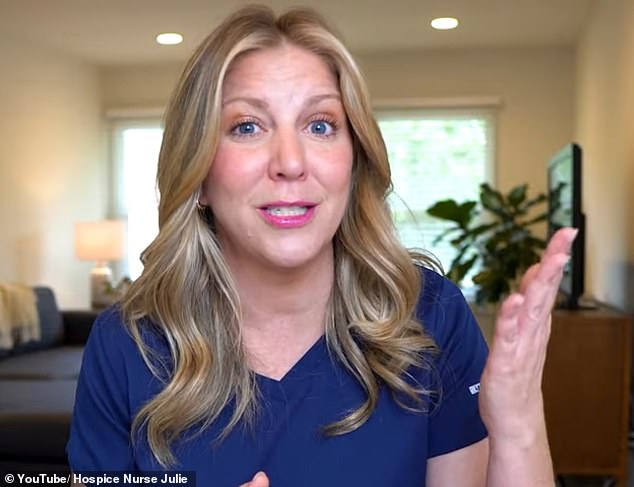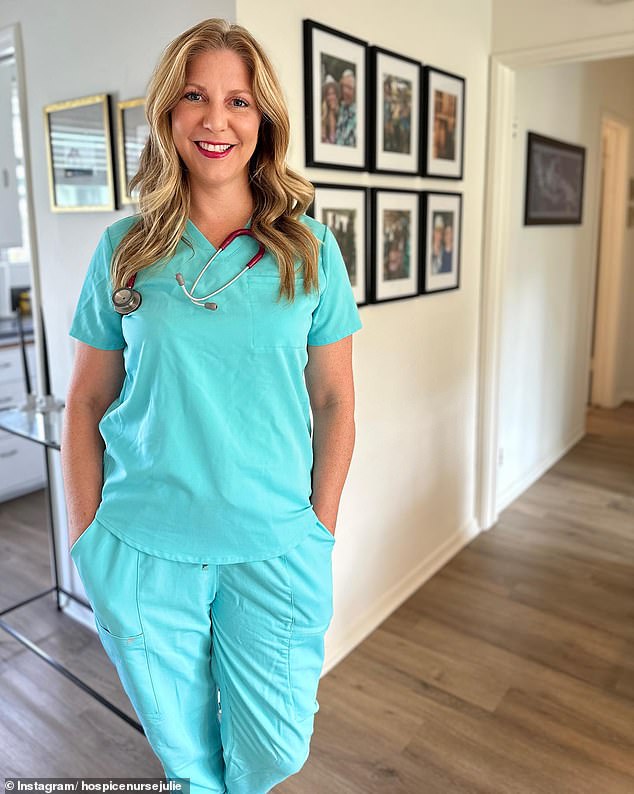A hospice nurse has shared an intriguing insight into the ‘death stare’ – revealing the truth about the common phenomenon that signals when someone is close to passing away.
Julie McFadden, 41, is a registered nurse based in Los Angeles who specializes in hospice care—and has built a social media following of millions by sharing insights to help destigmatize the process of ‘death and dying’ which her website declares.
Recently, she took to YouTube to share details of something that happens to dying people when they die – revealing how their eyes can become ‘fixated’ on a single point.
“If you’re not familiar with end-of-life phenomena, there are a few things that happen at the end of life for most people,” she explained.
‘One of the things is called a death stare, which is when someone gets really fixated on a certain part of the room and no matter what you do – you can snap your finger right in front of their face – and they won’t move their gaze.’

Hospice nurse Julie McFadden, 41, took to social media to describe signs of the end of life known as the ‘death stare’
‘Sometimes they just stare. Sometimes they will talk to someone you don’t see. Sometimes they will have a big smile on their face as if they are seeing something that clearly makes them very happy. So it’s called the “death stare.”
The ‘death stare’ is often accompanied by what Julie called ‘end-of-life visioning’, where the dying person claims to see someone they ‘usually love and know’ who is ‘dead already’.
“They’ll sometimes have conversations right in front of us with these people that we don’t see,” she added of the creepy incident.
She then shared a hair-raising story where an elderly man was already exhibiting both ‘death stares’ and ‘end-of-life visioning’ when she had checked in with him for a ‘follow-up visit’.
The man’s carer was his wife; both were in their mid to late 90s and had been married for 70 years.
‘I instantly loved these two. They were so, so, so cute,’ Julie gushed.
“He was what I call ‘pleasantly confused,'” Julie continued, explaining that he knew who his wife was and was polite to everyone, but couldn’t exactly hold a conversation or seem to know what was going on more generally.
“I noticed he would look at me and smile, then suddenly turn his head and be fixated on another part of the room, and then smile this huge smile like he saw something over there,” Julie further recalled.


‘Sometimes they just stare. Sometimes they will talk to someone you don’t see. Sometimes they want a big smile on their face,” she elaborated on patients who are close to dying.
And he kept doing it throughout the visit…I couldn’t get his attention when he wanted to do it. And then suddenly this big smile came on his face.’
Julie decided to call the wife: ‘I wanted his wife to see this because many times these end-of-life phenomena can give you a timeline of when this person is dying.’
It usually starts a few weeks to a month before their last moment, Julie added, stressing that she wants “family members to see it too and know what’s happening.”
The wife then told Julie that the husband had already been doing the ‘death stare’ for about a week, several times a day.
With that, the wife had gotten answers from her husband about what he was looking at – which, Julie said, ‘doesn’t always happen’.
”He said ‘Jesus,” the wife told Julie.
Julie went on to emphasize that ‘the point of the story is not that he saw Jesus.
‘Because many people say they see many different things. And it usually depends on what religion they are.
‘Sometimes they don’t see any kind of deity at all. They say, you know, “I see beautiful clouds” or “I see flowers.” Some people see Jesus or God or angels.
“But the amazing thing is that whatever he saw, he was very happy and he was smiling,” Julie emphasized.


The Los Angeles-based nurse practitioner has performed hospice care for more than 15 years
But things got weirder from there.
The wife took Julie into the living room and began to show her her family album.
She also brought up that her sister had just passed away.
Considering that the wife, her sister and the husband were all very close, she didn’t have the heart to tell her husband about her sister’s death as she thought it would just make him ‘super sad’ and that he would probably soon forget as well.
But after about a week, the wife, out of guilt, decided to tell her husband that her sister – his sister-in-law – had passed away.
To this he had calmly told his wife that he already knew so much – because the sister had told him.
“She came to me last week and said she was dead,” the man had told his wife about her sister, according to Julie.
With that, he had said that ‘smiling, like he was okay with it,’ she continued about the wife’s story.
‘I’m giving you chills just telling you this story,’ the nurse further admitted.
This is not the first time Julie has opened up about ‘end-of-life’ trends she has witnessed.
Last year she delved into ‘end-of-life visions’ and how eerily ‘logical’ the exchanges around them can be.
“They’re usually functional and logical and ask me, ‘Why do I see my dead mother, do you see her?'” she said.
Later this year, Julie will too publish a book entitled Nothing to Fearbilled as a ‘comforting and informative guide that demystifies our end-of-life journey.’
